Without electricity or natural gas, heating a home (especially in colder climates) can be difficult. Most modern homes rely on one or both of these sources for all heating duties.
These conveniences only became mainstream within the last 60 years. Prior to that, people figured out ways to live comfortably in various climate zones. Even today, some people choose to live an off grid lifestyle and are able to do so without electricity or fuel supplies.
What do they use instead of electricity, and natural gas? Read this article to find out!
Using Wood for Heating
In most areas of the country, firewood is readily available. A few days work chopping and splitting wood can yield a couple months supply, so read our article on the topic if need to delve into the practice of woodcutting and splitting your own wood.
There are certain types of trees that are more suitable for burning than others. This applies for both heating and cooking purposes. Dense hardwood trees burn longer and more consistently than softwoods. Softwood trees, like varieties of pine, are likely to have pockets of sap or air that can burst and spread fires to unwanted areas.
Read the article that we’ve featured here on Survivopedia on which types of trees or wood are best used for burning for extended info on the topic.
But you should be aware of the new EPA rules on wood-burning stones. They have issued new regulations, which limit the amount of particulate emissions from new wood-burning stoves to 12 micrograms per cubic meter of air. This new regulation is a reduction from the old regulation, which allowed 15 micrograms per cubic meter of air.
Read our article on the new EPA rules here.
Wood Stoves
The easiest, and by far the most popular, method of heating your home in a survival situation is a wood stove. In a survival situation, versatility is essential and the wood stove has many uses in addition to its primary duty as a heater., it can be used to cook food and heat your home and water.
The hot outer surface of the wood stove can easily cook food using standard pots and pans. Copper tubing filled with water can be run near the furnace to heat up water for bathing. Typically made from iron, a single wood stove can heat an entire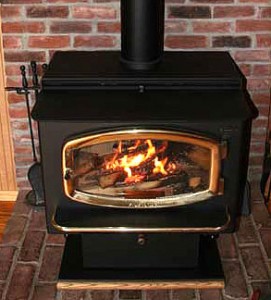 home.
home.
Some wood stoves are placed directly in a central area of the home. This is the most effective method, especially when using a smaller stove.
The only drawback to this method is that sparks and burning embers can fall out of the stove and potentially cause a fire.
For this reason, it is best to place a wood stove in an area of the home that is a safe distance away from flammable furniture or upholstery.
The stove can also burn skin quickly; a consideration important for homes with small children.
In homes with a basement, the wood stove can be placed down there to reduce the risk of fires and burns. The heat from the stove naturally rises and can heat most homes even from the basement.
Many people have had success routing the heat from the wood stove through the duct system already in place for a standard furnace. Care must be taken that noxious gases are not being introduced into the home and some sort of forced air system would have to be installed to move the hot air through the house effectively.
If you are considering a wood stove, make sure you install a proper chimney to allow poisonous smoke to escape the home. Drilling a hole in the roof is the most common method. If you already have a chimney in your home, an insulated pipe can be run from the wood stove to the chimney instead of cutting a separate hole.
Wood stoves use a lot of wood; especially in the cold winter months. Even when you go to sleep at night, the fire often extinguishes leaving your house cool in the morning.
One way to increase the length of time between refills is to mix dry, seasoned wood with green wood. The dry wood will burn immediately and dry out the green wood as it does. By the time the dry wood has burned out the green wood is dry and burns easily. By mixing the wood in this manner, the stove can maintain a constant temperature output for longer periods of time.
Wood Furnaces
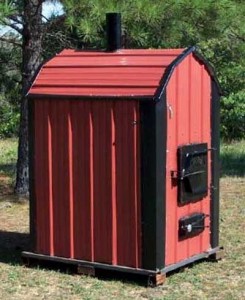 Unlike wood stoves which are designed for use inside the home, a wood furnace is a larger unit designed for outside use.
Unlike wood stoves which are designed for use inside the home, a wood furnace is a larger unit designed for outside use.
Due to their larger size, furnaces typically only need to be refilled once a day. The risk for fire or accidental burns is also minimized.
Heat from an outdoor wood furnace is transported into the home using ducts. These ducts should be buried underground for maximum efficiency in cold weather. Commercially available wood furnaces often have tubing integrated that is designed to heat your water as an added benefit.
The only drawback to a wood furnace is that if you have not already set it up prior to an apocalyptic event it is unlikely to be a practical solution for you. They are extremely large and heavy making transportation difficult at best.
However, if you install one now it will be ready for use whenever needed by simply lighting a fire.
Fireplaces
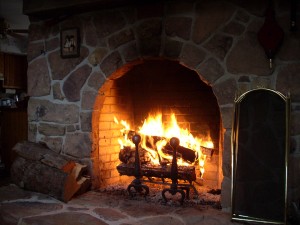 Traditional fireplaces have been used to heat homes for centuries. Unfortunately, they are better suited as an ornamental piece than as a serious home heating solution.
Traditional fireplaces have been used to heat homes for centuries. Unfortunately, they are better suited as an ornamental piece than as a serious home heating solution.
A fireplace is better than having no heating solution at all but they are known to be as much as 70 percent inefficient meaning that most of your heat is going up the chimney with the smoke and ash.
If you do plan on using your fireplace to provide heat, make sure you have a high-quality flue that can keep cold air out when the fireplace is not in use.
Also consider putting reflective material in the back of the fireplace. This helps to radiate heat back into the home instead of up the chimney and out of the house.
Heaters and Power Generators
Ranging from refined fuels such as gasoline, diesel and propane, to natural resources including animal dung and coal, there are many other sources than wood available to use off-grid for heaters or power generators.
One note to consider: if you store enough fuel to last for months or years, you are storing a lot of potential energy in one place. Good fuels must store a lot of energy in order to be effective, and this causes safety issues when storing and using them. Whatever your choice is, be aware that fuels can harm you too, so you need to be really cautious whit the safety needs for this particular stockpile.
Gasoline
For powering generators or fueling cars, gasoline is great, but it presents a number of problems to the steadfast prepper: extensive treatment and refinement of crude oil, and also gas supplies are apt to be quite finite in case of SHTF. Typical shelf-life for gas with appropriate stabilizers is anywhere from 6 – 18 months, but gas can potentially be stored for 4 – 6 years under the best circumstances.
Diesel
While diesel, like gasoline, requires treatment and refining from straight crude oil, diesel is generally cheaper than gas and can usually be stored for 2 – 3 times as long as gas, or longer. Treated with stabilizers and other additives, diesel has been known to last upwards of 10 years while retaining good viability.
Biofuels
After disaster, traditional gasoline and diesel fuel will likely be scarce for a few days, or it may be months, years, or forever, but there are a few biofuel crops for survival that you can grow and convert into fuel on your own. Read here about them! Basically, if a crop produces an oil, it can be converted to biofuel, though yields vary drastically from one type to another.
To make biofuel from any of these products, you’re going to need some type of natural oil, methanol, and lye. You’ll also need the proper equipment to make it so study up on it.
Propane
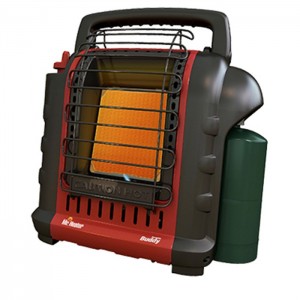 Portable propane heaters also work well. But due to their reliance on fuel they are not considered a sustainable asset.
Portable propane heaters also work well. But due to their reliance on fuel they are not considered a sustainable asset.
Propane can be stored for years without deteriorating unlike gasoline or kerosene making it the only viable choice if you decide to use fossil fuels at all.
Eventually even your propane supply will run out so this is best as a short-term solution or for situations when the wood stove isn’t enough.
Coal
While it’s mostly used for industrial applications and electricity generation, coal is still an immensely important fuel source to this day. Ranging in color from shades of brown to matte black and polished jet black, types of coal range from lignite coal to bituminous coal and anthracite.
Low-grade coal is typically used for heating or cooking, and for electricity production, but the highest grade anthracite coal is generally used for industrial purposes like smelting metal.
Animal Dung
Dried animal dung has been used throughout history in many cultures as a source of fuel for heating and cooking when other fuels were scarce or unavailable.To this day, animal dung is regularly used as a fuel by billions of people worldwide for heating their homes and cooking their food, a practice that is not only effective but also economical.
As a natural byproduct of owning or managing livestock, animal manure is also a renewable resource.
Using Nature’s Power for Heating
Solar power is the most well-known alternative energy source, but it is not always a viable option for everyone, especially those who live in northern climates where daylight hours are short or sunlight is scarce.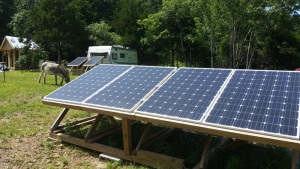
If you live closer to the equator and have sufficient sunlight and the necessary do-it-yourself skills, though, solar power can be some of the cheapest of alternative energy systems to set up.
Read this Survivopedia article to find out more about natural alternative energy sources!
Passive solar heating uses the intensity of the sun to heat homes quite efficiently.
Assuming you have a well-insulated home, you can take advantage of passive solar heating simply by opening the blinds or curtains of sun-facing windows during the day. Proper insulation – click here to read more on this topic – helps to keep that heat in during the night hours when the sun is no longer heating your home.
As for the solar panels, in addition to being lower cost and easier to set up, a standard array is very low maintenance and has an extremely long lifetime. Such panels can be left unmonitored for extended periods, their operation is silent and unobtrusive, and they offer reliable, predictable levels of power output based on the amount of sunlight they receive.
As a do it yourself project, solar panels average $3.00 – $6.00 per watt or more to install. Small, preassembled solar panel kits are also available from many retailers and are capable of producing anywhere from 45 watts to 150 watts of energy, and range in price from $200 – $600 and higher.
The downside of having solar panels is that you need protection in order to keep them working after an EMP. To shield against the maximum theoretical electromagnetic pulse field (EMP) strength (50 thousand volts per meter) of known nuclear high-altitude EMP (NHEMP) detonations, we must shield our solar panels to 74dB over a frequency range below 64Mhz.
But let’s be honest: shielding is something to take into account for all your electric gear, not only your sonal panels. And riding this Survivopedia articles on how to protect your solar gear in case of an EMP – Part 1 and Part 2 – will help you find a lot of answers!
Heating Using Compost
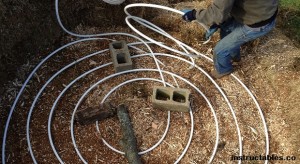 The idea behind using compost or mulch for heating is to capture as much of the generated heat as possible and use it for various purposes around the house such as reducing your electricity bill, heating bill etc.
The idea behind using compost or mulch for heating is to capture as much of the generated heat as possible and use it for various purposes around the house such as reducing your electricity bill, heating bill etc.
Biodegradation is the process that makes the magic things happen in your compost pile and that means that the trillions of microorganisms living in your compost or mulch must be “happy” if you want to obtain the best results.
The basic principle of compost-heated water is to use coils of plastic pipes driven through the compost piles, then pump water through them. The heat transfer occurs between the compost and the water and voila, you get hot water for free.
Read this Survivopedia article about heating using compost for more knowledge on the topic!
Home heating without electricity or gas may seem like a lot of work. The truth is that people lived in this way for thousands of years prior to the advent of modern technology and infrastructure improvements.
A serious survival situation will set society back to a more primitive state and heating your home with these methods is the only way to ensure long-term survival. So don’t waste time and prepare for using at least one alternative source of heating for your house!
This article has been written by Bryan Wilde for Survivopedia.





























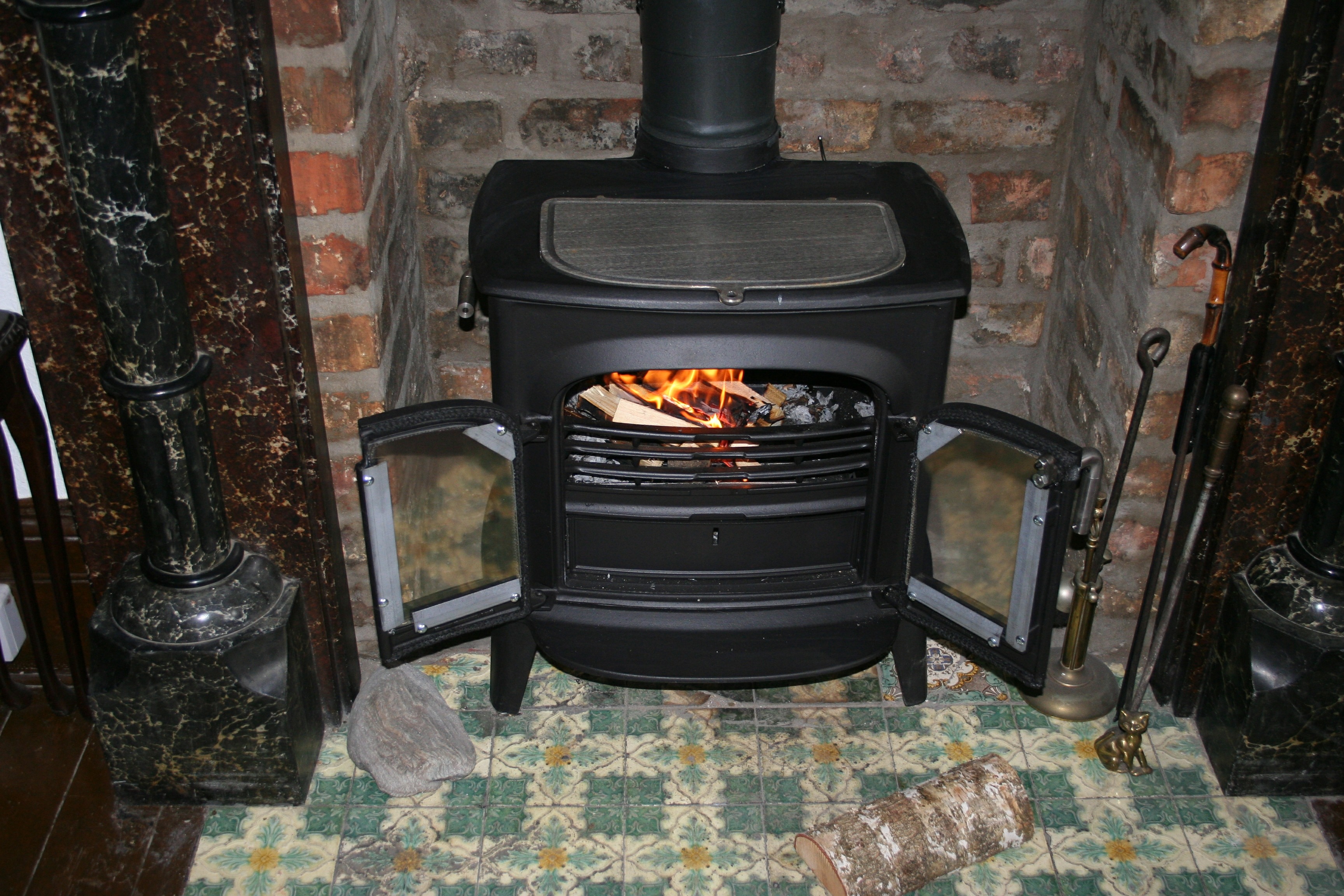
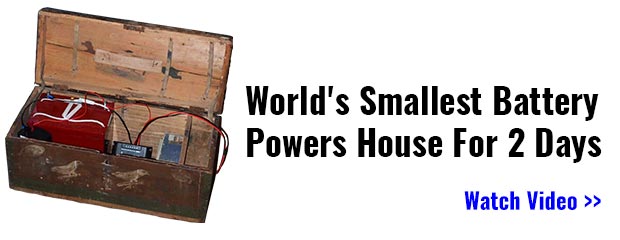























































Be sure to stockpile some warm clothes and blankets, going to help a lot.
When the SHTF so will electricity. There will be no way to use a wood furnace to heat your home because you have to have power to run the the fan. If you dig a hole near a place where you can tie into the duct and put the furnace there, the duct work can be run into the house and the hot air rises principle can be used to duct the heat into the house.
I have a (Yukon) Klondyke wood/coal burning furnace (yes) it has a Electric fan in it ,it’s piped into the Ductwork under my Trailer,BUT in the dining room duct vent,(Vent off) I have a 12 volt fan laying there constantly bringing the heat into the room, 24/7 powered off my 370 watts of solar to (4D) battery’s the electric fan rarely runs, when I loose power not a problem. this is the third year of doing the same thing. not a problem for me what so ever.
as for wood. when you see a field that was just cut over, many land owners will gladly GIVE you all the free scraps left behind, People with woods will gladly let you have all the dead stuff too JUST ASK.
Keebler in the southern woods of Virginia,
Good tips here! It is also a good idea to install a carbon monoxide detector in your home, especially if you use a wood stove.
That would be an unpleasant distraction. Every time you opened the stove, day or night, the blooming thing would go off, destroying your sensability, sanity, stability, temper, and waking every one in the house up to the fact you are up loading the stove. I guess if the stove is in the opposite end of the house, you could put one in your bedroom if you closed the door, oh, but this heat thing gets in the way. Close your bedroom door and you receive no heat, open it and the alarm goes off. Been there, Carbon dioxide protector will not work with a stove or fire place in operation, sorry your suggestion will not work. One other thing, the SHTF where do you get the batteries to run the Carbon dioxide protector. Your idea does not work no matter which way you look! PS. THE GOV is planning just such a thing right NOW!
Get yourself some rechargeable batteries and charger. Also get a solar
panel to plug your battery charger into.
Remember that solar anything needs batteries. Batteries for the solar panel also need to be charged with…you guessed it…electricity! In a grid down situation, I mean really down…for a looong time. I would not rely on solar for long periods of time without electricity..
Like the poster said above…it’s all being planned.
I have a small solar battery charger in my BOB for AA and AAA batteries, and larger solar panels with al the trimmings for larger ones. The trouble wih the larger ones is keeping the hidden in a grid down situation. I have some mine mounted on top of my camper out back, others elsewhere. For heat? May have to get cozy with an electric blanket as a last resort. Charge the batteries with solar or windmill (with appropriate apparatus), run into inverter to provide AC. Should be enough to keep you warm at night.
I want to help you a little bit ,”want to preach” The detector you need is a CARBON MONOXIDE DETECTOR, NOT a carbon dioxide detector. You see, Carbon MONOXIDE is DEADLY where carbon dioxide disapates fast enough that is is not deadly, unless it is the only thing you re breathing. The air around us is 21% Oxygen and the rest is a mixture of carbon dioxide, nitrogen, hydrogen and a few other inert gasses.
You do not need a carbon monoxide detector for anything that involves burning wood. The reason being, CO 101.. Carbon Monoxide is a byproduct of burning fossil fuels, like propane, oil, kerosene, you get the drift. Wood is in no way a fossil fuel and in no way produces CO, when being burned. You would also want to swap you smoke detector closet to the area where you are burning to a Ionic detector, as apposed to Photoelectric, which would go off more frequently.
Wrong!!!!!!!!!!!!!!!!!
Wood is a carbon compound (it makes charcoal, doesn’t it?, and charcoal is carbon mainly).
Fossil fuels are formed from vegetable matter including trees (and maybe a few animals thrown in for flavor)
Incorrect medic394, the gasses you burn when you burn wood are the VOC’s and carbon monoxide(CO). When carbon monoxide bonds with oxygen (combustion) to add another oxygen atom it forms carbon dioxide (C02) which is less harmful than carbon monoxide. The cleaner burn you have the more CO get turned into CO2.
To all those that can’t determine the difference between CO and CO2…………
https://www.co2meter.com/blogs/news/1209952-co-and-co2-what-s-the-difference
I don’t mean to correct you, but it is a carbon MONOXIDE detector. like the fumes that come out of the exhaust of your car that you can’t breathe. Carbon dioxide is what you exhale when you do breathe.!!!!!
We have heated our 4300 sq. ft. house with our Hearthstone soapstone woodburning stove for many years. We live in the midwest and our wood stove burns 24/7 from November until April. If your stove is vented to the outside with flue pipe, there is no issue with any gaseous or byproduct dangers. the flue pipe also draws the smoke outdoors, opening the door of the woodburner is never a problem. Just don’t leave it open or it will draw the heat out of your house!! Enjoy the radiant heat with the woodburner door closed 🙂 You can also put a small fan by it to distribute the heat, but it is not necessary.
We also have a cast iron wood burning stove at our cabin. Like the one at our home, it is vented to the outside with 6″ double-walled flue pipe.
We safely heat with these stoves, cook on them, and heat water on them. We always have, and still, cut and split our own wood, even though we are now 68 and 71 years old.
We do have a propane back-up which rarely kicks on, since our house stays so cozy and warm. We only use about 100 gallons of LP per year!
Please do not fear heating with wood. Just vent it to the outside and you are good to go 🙂 Enjoy the coziness and low cost of wood heat.
You go girl!! I wish we could have a set up like yours. Sounds great!
Have anyone tried solar passive heates? I heard that these can heat up to 150 degrees above …
And use it where in the midwest? We have experienced this year the most cloud cover I ever remember in my years. How do you use solar heat w/o solar? The winter is liable to be a bear of a winter if the cloud cover stays.
Did you ever get sunburned on a cloudy day? I have. I live where we get more cloudy days than sunny; yet, solar works well here. There are even solar panels built where they do better in cloudy weather than on sunny days. Those are what’s being used on the Capitol Building in Oregon right now. please reconsider solar.
I have a solar battery charger.
I tried to use it on a cloudy day and he meter hand wouldn’t even move.
Just be sure to have a shoe box full of charged batteries at all times.
How does one use a solar panel when the skies are filled with toxic chemtrails that block out much of the sun? These are ever increasing where I live and will continue to increase around the world. Look up chemtrails online.
The lack of good sunshine had caused a lack of Vitamin D in humans also causing many diseases related to lack of vitamin D. Basic elementary school science also tells us that plants need sunshine for photosynthesis and growing properly.
Without adequate sunlight solar panels produce less energy – personal experience with such.
LOL!, Jane, you’re funny! This is the second post that I’ve read from you and you’ve made my day. Either you’re not getting enough oxygen at your altitude, or you’re smoking (or eating) something that isn’t legal here yet. I have a feeling that you may have experience with solar panels, but your significant other must be the one doing the set up. You don’t need electricity to run your solar panels. You use the panel to charge your battery and/or produce electricity by using an inverter. Also, I would not be too concerned about chemtrails lol, and be more concerned about when North Korea will hit us with an emp.
I grew up VERY poor and here in GA passive heating AND cooling is entirely doable.We didn’t know it was called that, butwe didn’t have central heating and air so we made do.
Tips for heating: close off unused rooms. Put curtains in doorways without doors as this helps to trap heat. Tack plastic or cloth ( we used o
ld towels) over windows to again trap heat. We even stuffed towels at the
* bottom of outside doors. Sometimes on really cold nights we’d all pile up in the living room and with the heat tapping just our body heat would sometimes make it not only warm, but uncomfortable!
For cooling we just figured out where the breeze was ( there’s always a tiny one, look for which way high limbs lean or put tissue on the ground and see where it blows) then open windows on that side of the house and the direct opposite. Keep all doorways between sets of windows open to promote air movement and keep all other windows closed to channel the breeze through your house. For times of plenty, box fans in the windows bringing in the breeze facing into the house and more in the windows letting out the breeze facing out will significantly cool a home!
I grew up the same way. In NC our winters can be downright brutal and we’d have to have kerosene or propane to heat our house. We’d cover windows and use box fans to pull the heat to other rooms. No, using fuel will not be a great way to go when the SHTF, but since it hasn’t just yet, its a great way to heat your home and save money on your power bill. For SHTF scenarios, a wood stove is probably your best bet. We eventually got one when I was growing up. They heat wonderfully and you can use them as a cook top. If the SHTF, you won’t have everyone in separate bedrooms anyway. Everyone would be in the main area of the house (Kitchen/Living room). Have the wood stove in the kitchen and the family bunking in the living room. Theres no need for smarta** comments and general rudeness. Everyone will be affected when it all goes to hell so how bout being nice to people while you can. (Last bit not directed at Lori)
Georgia is a far different climate than the north. Winters in parts of Georgia touch on freezing to be sure, while some of Georgia also borders Florida, so its hard to know what sort of winters you describe. However Winters in Chicago do not get ABOVE freezing for months and months. Literally wake up and turn on the news and for all of January through March its temperatures between 13 and NEGATIVE 13 degrees at 6:00 a.m. Brutal cold that will kill a person overnight without heat. It was a really cold, I do not know why I stayed so long (17 years). I really am an architect. I have studied up on Passive House Certification for clients and believe this is a great system for those of wealth to apply to new home construction. But beyond most budgets, and not readily achievable with an older home. If you believe a long term grid down is possible, please study some history of worst case, such as WWII battle for Stalingrad, just awful. death and eating rats, burning the dining room table and tearing out walls for wood to burn to survive. If you cannot leave climates such as Wisconsin or Minnesota, then a back up heat source is a necessity. here in the Pac NW we have so much timber , that wood stoves are so common as to be primary heat for many. if timber is scarce consider a coal fired stove. Coal can be stored for years in bulk, purchased by the ton and not loose effectiveness over time. Fuel Oil (Diesel actually with dye) is a good heat source, and more convenient to use but one cannot usually have 5k gallons stored in bulk, and it must be treated with additives for long term life or it will spoil.
Finally, those in the harshest climates who truly believe an extended grid down season is coming would do well to relocate. We did and can testify that there are better places, better climate, nice people, and healthy living to be found in the Pac NW.
Well I have lived in the north. Michigan, for years and also Florida and I’ve been darn cold in both places. When it get 22 below and the wind is out of the north, it doesn’t matter how much heat you have or how much insulation the wind will blow the heat right to the other end of the house and out ! Then again when we moved to Florida we thought it would be warm all the time! Not so ! There was no furnace in the house that could be used; and all the windows were jalousy. When it was hot it was hot and when it was cold it was cold. The neighbors left their hose running all night and had an ice pond in the middle of winter in central Florida. We had no heat and windows that let in all the winter cold. So for the emergency I covered all the windows with plastic then on the inside of the bedroon windows I taped aluminum foil to the plastic and right away it raised the temp. in the room and when the kids were in there playing or sleeping they were as warm as toast. I suggest that people get as many foil emergency blankets as they can and if it is necessary they tape or tack them over their windows and across the doorways that have no doors. Make draft stoppers from old rags to place in front of the bottom of the outside doors to stop drafts. Be sure to close window curtains if the windows leak air, or stock up on clear plastic so you can tack it to the outside of the windows to stop the cold air from coming in. Think about these possibilities ahead of time and plan for such things. We have. I hope everyone else will too. Not everyone will be able to afford the costly things but where there is a will there is a way. My father told me of the winters when he was a kid in northern Mich. that he woke up in the morning and there was snow on his bed ! As a kid I remember a rug on the bedroom floor that I thought was a bear hide; come to find out years later it was the hide of their old horse ! They made use of everything they could and we will have to learn to do the same ! God Bless
We made a heater with soda cans and it works great! Yes, you do need some sunshine to make it work, but on clear, cold days it works very well, so those are the days you can turn off your electric heater or save your wood for the nights! If you would like to see it, go to my website at http://makingoursustainablelife.com/soda-can-heater.
well, for heating with wood is a great idea, and if you still have time, go and purchase alot of wood and store it in a safe location away from prying eyes, also buy alot of ammo too, you can trade ammo for wood and food, also find a way to get a steady supply of underground water or a big tank underground if possible, sleeping bags are a good sorce of holding your own body heat to a comfortable level and you will use less wood or kerosene, ok, stay safe and warm, winters cold is just around the corner, miguel
when power goes out, just where do you think you will get the kerosene when your supply runs out?
We have 0° sleeping bags for this purpose.
Haven’t had to use them yet. All Lori mentioned, we do. We have 12 rooms counting the bathrooms and only heat the kitchen when I use it, the den, one bedroom and bath.
The propane company won’t answer the phone, so when we got to 30% reading on the meter, we started using little electric space heaters and they are doing fine for just the room I am in.
I would rather pay .25¢ an hour for those than $12 for 6 hours which is what our heat pump cost when below 32°. Yep–I read the meter constantly on our electric and propane.
Bought 65 y old 1,000 one floor ranch in U Penn. Discover that hi eff gas furnace Goodman 2010 replaced wood/coal metal furnace still in residence off to one side. Existing ductwork used. Grew up in house w/ wood coal gravity rise furnace in basement. Surprised to find house unheatable. Extremely high electricity costs.
Reading on net discover hi eff draw in outside air which in this case is pure stupidity as basement sufficient to furnish air already slightly warmed over the 90% humidity cold air from the outside. So spent first winter here freezing at 62 due to high humidity circulated by the hi eff furnace. Light bills for 1/2 house as other closed off near $200 even without wash/dry and one person. This winter bought two electric heaters, one mica and one oil. Mica operating on low 750 watts keep small den 72. Only other heated area kit and hall to den/bath. Med setting on oil heater. Mild Nov and Dec 2015 gave $350 light bill. UPPCO service unaffordable.
Previous owners failed to correct problems and I suspect they cut into the ductwork and connected a heat exchanger transferring heat from a wood stove maybe the old furnace or a wood stove they took with them.
So basically I am on track to lose the house because it cant be heated without substantial costly changes even tho it a Rural Dev inspected property. Talks with realtors produced no results, inspector dodges me, legal options not feasible as 70 y old widow.
The article was very informative however the outside wood furnace overlooked one HUGE thing. I have had one installed at my own home since 2004 and mine is a boiler as most of them are. They heat the water in the lines that then are circulated into our home and other structures. Therefore, I still need electricity to circulate the water in the lines. HELP!
Here’s a method to circulate hot water in the lines. Is called termosiphon (click here)
Or you can build a solar heated hot tub (click to read more)
I have experienced solar and batteries with a converter to change 12 volts into110VAC. This can run your pellet heater for a day or two, without recharging.
I also have installed, oil furnaces, wood heaters and Pellet Heaters, I have found that the Pellet Heaters are the cleanest and most simple to maintain and the most safest going. Pellets in bags of 40 Lbs. Can produce a terrific amount of heat, they can be absolutely automatic, from Hi- Temp to Low Temp or right off, they are self igniting, and hardly any ash.
Jim.
modify your system. ductwork out the top with waterproof insulation on the pipe to the house, then dig the return line and bury it. but best move is to sink it to give you the ability to duct the heat into the house. Make sure you put a sump (not pump) in it or have a way to drain any percip off.
could also buy a solar with battery backup to run pump and house fans and convert to DC motors.
A rocket mass heater is the way to go. Lot’s of information and video’s out there ,start at youtube.
I up arrowed you because I really do like rocket stove technology. However please note all these systems i am aware of are home developed, personally built. I mean I am not aware of a UL listed or EPA “Rocket Stove” product you can buy “off the shelf” like you can for a high efficiency wood stove.
So when we looked into Rocket stoves, I found that I would be voiding my home owners insurance, and not able to get a building permit for one because of the rocket stoves smoke draft circulation system does not meet building codes.
If you don’t care about such items, and can build one yourself, or with an experienced contractor, then a rocket stove is a great heat source. However there are actual masonry thermal mass stoves which can be built to code specification and/or Soap stone wood stoves which are an EPA and UL listed products. The latter cost about $2-3k, and the former, $5-$15k and you wont loose you homeowner’s policy
I KNOW THIS IS OLD ARTICLE AND COMMENTS I JUST WANTED TO SAY I PURCHASED A ROCKET STOVE ONLINE
Do not forget to chec with your city or town befoe installing a wood stove to make sure you with any code.
Yoy could get a trickle charger for solar to keep some batteries charged up
If you want to heat with wood in the North you probably need a small house and a very good stove. Non of the cheap cast iron ones. I have heated with coal for years with a small Godin stoves (picked up on Craigslist) which will burn both wood and coal. These stoves will not burn out grates like some coal stoves do. Keep a couple years of coal stored up and if the event goes longer start burning wood. Also coal doesn’t take as much room for storage and doesn’t rot.
Hello. Please research methane digesters as yet another sustainable way of heating a home..
for example… http://en.wikipedia.org/wiki/Anaerobic_digestion
You’re sure hence significantly when it comes to this topic, made us personally consider it from a lot of varied attitudes. It has the such as individuals are certainly not serious except it truly is think about accomplish using Rhianna! Your individual stuffs outstanding. Constantly care for this!
I am quite surprised that no one has mentioned ‘Rocket Mass Heaters’? These are by far the most efficient use of firewood. They’re permanently installed and take some planning but are well worth it. I’ve even heard of them being installed in apartments. Are there any cons to these?
Search online “Rocket mass heater” and study it. It’ll heat the house up quickly and use 1/6th of the wood you already use, if the fire goes out it’ll keep the room/house warm for another day.
Very inexpensive to build and maintain. I’ve designed one that’s works quite well with the use of a wood burning cook stove w/oven, works great! It leaves much to the imagination in design & style.
A “Rocket Mass Heater” is not a ‘Rocket Stove’, has nothing to do with those ‘Rocket stoves’ as they use some type of liquid fuel, this Rocket Mass Heater uses wood heat in small quantities and effectively uses almost all the heat produced, at the exit the temperature is less than 100 degrees.
I’m interested in your modification of old wood cook stove into rocket mass heater. Would you share? [email protected]
Fireplaces can keep the heat in the house if you insert blowers or ceramic. Here is an article. http://www.dispatch.com/content/stories/home_and_garden/2011/10/16/a-warmer-glow.html
I have to agree with the Rocket Mass Heater as the ONLY way to go. I haven’t built one – we rent our house right now. But my research tells me these are the most efficient, sustainable way to go, even the smoke output is supposed to be minimal, giving out less of a ‘signal’ of where you are – so much so that some have built these in places where fireplaces/wood stoves are illegal. Not to mention, they are much lower cost and relatively easy to build. I’ve just got to figure out how/where to build one with minimal damage to the home we live in, so that I can restore, if/when we move out.
During a very wet winter twenty years ago I learned that if I stripped the wet bark off of the wood and stood it on end the water would drain out and the wood would dry much faster. The bark holds in the water.
Something many are finding out this winter with such cold temps. Unless you have your store of wood for the winter, you may not be able to find wood for sale. That’s what’s happening in the midwest and new england. Another piece to know, bigger is not better when building a fire. Small and hot gets the job done better and if you have some mass along side which can absorb the heat, it can radiate out into the room. Just something I learned growing up in a primitive area.
We have one of these in the den:
I had trouble getting heat to the back bedroom through a really long hall.
I put a little fan on top of the mantle out on the edge.
It increased the hallway temp by 5 degrees and therefore sent the heat to the bedroom.
Simple measures with great results.
The heat resting over the mantle which is really big was now directed to the front.
http://www.factorydirectfireplaces.com/breckenridge-vent-free-36-corner-fireplace-package.html
OOps, here is one like ours…sort of.
My husband and I made a solar heater out of soda cans and it works very well! The temperature coming out of the heater is 150+ degrees – even on the coldest days. Of course, it only works when the sun shines, but is a good back-up for those days when the sun is shining but it’s still freezing outside. It’s also a good way to warm up a garage or shop, or even a chicken coop! if you want to see how we made ours, you can go to my website “makingoursustainablelife” and click on the DIY tab. It was actually fun to make!
I have a ‘Yukon-Klondyke) wood/coal furnace..it has 115 Vac fan When I added it in the Basement I made sure the output Duct work was Upward a small amount for natural air flow. I bought a 12 volt DC fan @ w/mt. $ 14.99 (o2-cool) it lays on top of the output vent the dining room, pushing heat in the room, I run it off my solar 12 volt system & battery’s. runs all winter.(free) sort of. keeps my house nice & warm.
keeb.
diesiel isnt by any way cheaper than gasoline though the diesiel can be stored above ground in laarge cans unlike you said because it needs that high compression to properly ignite in most scenarios
Keep in mind that burning green wood increases creosote buildup. This can increase the risk of a chimney fire.
I like wood fireplace. Moreover, solar system is not bad. Thanks a lot for these impressive information.
Personally I’m a fan of wood fireplaces, especially if you are up north and have ample trees avaialble. Plus nothing beats the smell and feel of a good ‘ole crackling log fire.
Thanx for sharing the great post..
Would love to know where people in the Pacific NW buy coal. Haven’t been able to find any for at least a decade!
I like what you offer but your website won’t allow me to make PDFs of the articles I’m interested in.
Your tips look great. Very helpful for me.
You are very welcome!
Alex, from Survivopedia
Thank you for sharing. This is a great idea to welcome your friends in a beautiful space.
If I put a wood stove in the basement, will it heat my house? Do I need to cut vent holes in the floor for the heat to come in, or would I be better off getting an outside wood furnace?